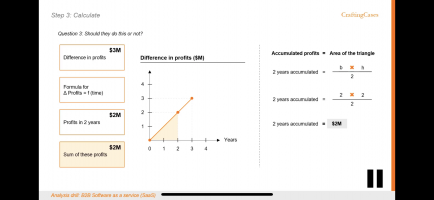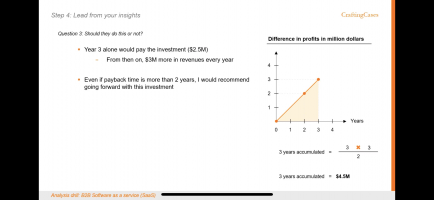Hello guys,
I am struggling with understanding the concept of “accumulated profits“ in the context of this graph given.
For context: The graph plots the increase in profits (and not profit earned per year) for successive years, so profits increase at an increasing rate for this company, and we need to know if the investment worth 2 M is worth it, considering the client wants his money back in 2 years max.
• What I did not understand: when we can already see that for Y2, increase in profits from year 1 is 2M, which is equal to the value of our investment; why are we calculating the area under the line graph?
What is the significance? While I understand what this means conceptually, such as calculating the distance in speed-time graph or work done in Force-time graphs, I don’t know what accumulated profits actually mean in this context.
I am at loss of words, I‘ve been trying to understand this for over 8 hours now and I feel dumb.
What do accumulated profits even mean here?


I am struggling with understanding the concept of “accumulated profits“ in the context of this graph given.
For context: The graph plots the increase in profits (and not profit earned per year) for successive years, so profits increase at an increasing rate for this company, and we need to know if the investment worth 2 M is worth it, considering the client wants his money back in 2 years max.
• What I did not understand: when we can already see that for Y2, increase in profits from year 1 is 2M, which is equal to the value of our investment; why are we calculating the area under the line graph?
What is the significance? While I understand what this means conceptually, such as calculating the distance in speed-time graph or work done in Force-time graphs, I don’t know what accumulated profits actually mean in this context.
I am at loss of words, I‘ve been trying to understand this for over 8 hours now and I feel dumb.
What do accumulated profits even mean here?



